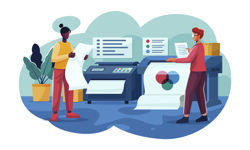The second internet gold rush is happening right now, and the two biggest stories have been Rupert Murdoch’s purchase of MySpace and Google’s takeover of YouTube. Those of us who worked on the web at the start of the decade, experienced a small shudder of anxiety upon hearing these stories. It was like 2000 all over again, when the whole world went dotcom loopy and everyone seemed to work for an internet ‘start-up’. We all wanted to be Martha Lane Fox, even the blokes, and no one could quite believe it when the bubble went splat.
But things were different back then. That was Web 1.0. Now, we’re told, this is Web 2.0. It’s a new age.
But what does this mean for you as a publisher? What are the opportunities and dangers? And what the hell is Web 2.0 anyway?
In the beginning, the web was all about the publisher. Professionals created content and put it on the internet for people to read. Just like a newspaper. The user was passive and the internet was just another way of consuming – very slowly, on a dial-up connection.
User Generated Content
At the heart of Web 2.0 is user generated content. The people who use the site, make the site. Or at least a substantial part of the site. The other major aspect of Web 2.0 is the social side – social networking and social bookmarking. Put all of this together and the best sites give the user a place to communicate, to be creative, to get together and network, to show off or share.
The spread of always-on broadband has contributed to all of this, along with the birth of a generation that doesn’t remember life before the net. The people who have driven the revolution are, as usual, the young. Social network sites MySpace and Bebo are dominated by teens and twentysomethings. But this doesn’t mean you should ignore Web 2.0 if you’re targeting an older, less tech-savvy audience. It will spread, just as mobile phones and downloading did.
But why would you want a site where the content is created by its users? The first answer is traffic. Content – words on the page, images and video clips in particular – equals traffic. On the most basic level, the more pages or posts you have on your site, the more you’ll appear on Google and the more visitors you’ll get.
User generated content is cheap too. Rather than having to pay journalists to write reviews or articles, your users can do it for you. Look at Amazon; although user reviews have long been part of their site, in the old days they used to pay critics to write reviews. Now the customers do it all – or the vast majority, at least. So what if it contains sixteen spelling mistakes? It’s the first thing we all look at when deciding whether to click ‘Add to shopping basket’. We all want to see what other people think. User generated content is real. It’s interesting.
Becoming indispensable
Basing your site around your users is one of the best ways of achieving an important goal: making your site an indispensable part of their life. Perhaps you provide them with a vital forum for networking, like Jigsaw.com, a site on which users exchange business cards, or a crucial source of information from their peers. If you work your way into people’s lives, they will never leave you. (Or not until someone else comes along and does it better, anyway, like when everyone deserted Friendster to join MySpace). For example, if you make your money from selling subscriptions, if you build blogs, or a valuable forum, or exclusive video content into the package, your subscribers won’t want to leave you.
Then there’s the social bookmarking aspect to consider. Everyone who knows anything about getting visitors knows the importance of linking. Google ranks web pages according to their content and links going in and out. Now you can get your users to do your linking for you by using sites like Digg, Reddit or Del.icio.us. These sites allow people to share links to stories and items that they think others will find interesting. At the moment, the stories that tend to get onto the homepage – thus causing a surge in traffic - are the ones that geeks find interesting, but this should change as more non-geeks start to use these sites. It’s another great way to drive traffic – and if you have anything about technology on your site you should start using it right now. The easiest way is to put a socialiser bar (or Iconistan) at the bottom of your articles or blog posts. See any news story on SportBusiness.com for an example.
I’ve tried to think of some olde worlde equivalents of user generated sites, and the only examples I can think of are Take a Break and the other real life mags and, er, Readers’ Wives. But, even then, there are always gatekeepers to filter and organise the content, to accept or reject. Now, anyone can share their story, their photos, their art, their opinions, their passions, their music, their movies… It’s really self-publishing on a vast scale.
So how do you actually make money from it?
The business model that most of the big Web 2.0 users are pursuing is based around advertising. Rupert Murdoch has already recouped the $580m he paid for MySpace by selling Google the right to place its search boxes on every page. Google is happy to do that because of the revenue it earns from the Adwords ads that appear alongside the search results. But how else will News Corp make cash from MySpace? The pages are a mess, with music clips, video, gaudy backgrounds, flashing gifs. How are advertising banners meant to stand out among that horrible lot? Advertisers have found much better ways of using MySpace and the other social networking sites, by creating pages (for free) for their bands or films. Eventually, Myspace is probably going to have to think about charging people to use it… by which point, going back to my earlier point, they need to hope that it’s such an integral part of their users’ lives that they are willing to pay. (By the way, if you don’t have a MySpace page, you should definitely set one up, and put a link on it to your site.)
YouTube are in a similar situation. They’ve never made a cent in profit – which is why no one has sued them yet for copyright infringement! They may base their revenue model on advertising: for example, showing a short ad at the start or end of each video clip, or next to the video. Or they may concentrate on partnerships – giving broadcasters and record companies a place to push their wares. There are already a number of brand channels on the site, for companies such as Capitol Records and CBS.
But, what about the smaller guys? Because of Google’s Adsense programme, anyone can make money from conceptual advertising on sites with a lot of content. Paste some code on your site and Google will place relevant ads on your pages. You get paid every time a visitor clicks on one of these ads.
Moderation
4urMobilePhone.com is a site on which people share themes and wallpapers for mobile phones. Phone enthusiasts create a picture and upload it. Then other users download the ones they like. The site is run by one guy from his flat; he provides the system then sits back and watches the Adsense roll in. The site is almost entirely moderated by its users too. So, if anyone uploads any ‘dodgy’ images, these unpaid moderators – who do it just because they like and value the site – will remove them.
While we’re on the subject, moderation is one of the big problems for anyone who has a lot of user generated content on their site. For big sites like YouTube and MySpace, moderation is almost impossible, although it’s the unrestricted nature of these sites which makes them so popular. For smaller enterprises, moderation is possible, though you will need to automate it as much as possible. For example, make people register before they can post (which also helps you collect leads); use ‘capture’, where you make users type in a string characters before they submit; block posts containing certain words; or, as above, encourage the community to self regulate.
As well as Adsense, you can attract more traditional banner ads too. TiredandTested.com is a MySpace clone for sportsmen and women, monetized by banner ads. Other sites, like SEOchat.com (articles contributed by users, a community of SEO experts) use Intellitxt, which uses linked keywords that trigger a pop-up when the user points at them. Or you can use your site to sell affiliate products. There are numerous networks that help people make cash online.
If you already have a publication, and a site, you can use Web 2.0 to create features for subscribers, as I’ve already mentioned. For example, WhatToExpect.com have exclusive forums and a Belly Buddies club, so that pregnant women can connect with other pregnant women around the world. And this sells more copies of their central products: the What to Expect books. You should think about how you can provide services and tools for your core customers.
At Electric Word, we recently launched a site called TeachingExpertise.com, which is aimed at teachers. We know, through Adwords research, that our users are most interested in getting free lesson plans. So we will soon be introducing a lesson plan ‘exchange’, where teachers can upload their own lesson plans and download their peers’. This will be free, because we see it as a way of making users want to visit (and keep coming back to) the site. We see this as providing a service that will help us engage with our audience and allow us opportunities to tell them about our products. And the site will use all the things that are transforming the web: RSS, blogs, podcasting, etc, etc.
Your Google listing
You might think about user generated content as a way of magnetising traffic. The more visitors – or rather, the more relevant visitors you attract – the more products you can sell and the more subscribers you will attract. NME.com have just started to allow readers to post comments on every news story. That means more keyword-rich pages which should translate into more visitors – and more subscriptions to the paper magazine. Wikipedia is a perfect example of a website where users put words on the page – millions of them – and help the site climb the search engine rankings. It might be my imagination, but Wikipedia always seems to be on the first page of Google. The same goes for Yahoo! Answers, where people post questions and other people answer them. Talk about a simple idea! And it’s one that anyone can copy, encouraging your users to talk about their specialist subject and create lots of content.
This really is the future. Honest. Because the best sites are those that make use of the internet to do stuff that simply wasn’t possible before. Sites that, at their heart, remember what the net is: a vast community of people connected by their computers. Look at eBay, in some ways the first Web 2.0 site, even though it started in 1995. All of the content is created by its enormous, dedicated community. It brings people together. It’s almost completely self-regulated. And it’s changed the world.
Now it’s your turn.
| Web 2.0 – some great examples: Social networking www.myspace.com www.bebo.com www.tiredandtested.com Video sharing www.youtube.com www.revver.com Image sharing www.flickr.com www.photobucket.com Social bookmarking www.digg.com http://del.icio.us/ Miscellaneous www.wikipedia.org www.4urmobilephone.com www.blogger.com www.jigsaw.com http://answers.yahoo.com |










